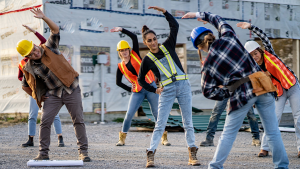The current system of safety rewards might do more harm than good, according to one safety expert.
Michael Fears, a CRSP and University of Calgary instructor in the occupational health and safety program, spoke at the BC Construction Safety Alliance (BCCSA)ŌĆÖs recent Health and Safety conference in downtown Vancouver.
His session, titled Improving Safety by (sort of) Eliminating Safety Standards, explained how current safety rewards programs gamify the process rather than treat it as a core value.
ŌĆ£My experience in safety over the last 20 years in a lot of talks IŌĆÖve had with senior managers, both in operational and safety as well as junior people, IŌĆÖve found that what we try to do with safety rewards just isnŌĆÖt as effective as it should be,ŌĆØ Fears said. ŌĆ£We treat safety rewards as a quick solution, and I think we make assumptions which are not based in good, practical experience.ŌĆØ
He added organizations should move from a focus on external rewards towards internal motivations.
ŌĆ£I think what weŌĆÖve done with safety rewards programs is that weŌĆÖve made safety within an organization something different rather than something thatŌĆÖs part of what we do,ŌĆØ he said.
Rewards programs can also lead to employees not reporting on incidents and even hiding injuries, Fears said.
ŌĆ£ItŌĆÖs a huge issue,ŌĆØ he said. ŌĆ£IŌĆÖve seen it myself. People break bones or they get ill and hide it. If we adopt a posture of having zero incidents as a goal, how do you function? ThereŌĆÖs very strong pressure not to report things, which is really bad because you end up in a situation where you arenŌĆÖt recognizing the errors that are popping up.ŌĆØ
Fears said rather than get rid of rewards entirely, organizations should find different rewards to give and different ways to give them.
ŌĆ£Recognize people who do well or improve and you do that without a reward,ŌĆØ he said. ŌĆ£Pat on the back, stroke the ego, and so forth. If that continues or blossoms into other activities and behaviours you find a reward that person would like.ŌĆØ
Fears also stressed while some people want public attention for their accomplishments not all do and it can be counterproductive to reward them in the context of a larger meeting or other similar events.
He added rather than call attention to a safety rewards program, management should focus on one-to-one interactions and work in the background.
ŌĆ£You want to treat it as if it is just a normal part of business, safety is just ŌĆśwhat we do,ŌĆÖ no different than getting your time sheets in on time, drawings are in on schedule,ŌĆØ he said. ŌĆ£Then it becomes who they are as an organization and as a group.ŌĆØ
Fears said rewards and praise should come from a direct supervisor, as then ŌĆ£it comes from the person delivering the reward, not the program or the organization.ŌĆØ
At the same time, Fears said, organizations should lead by example regarding safety programs.
ŌĆ£At the end of the day how an organization and people running an organization respond to incidents, problems and initiatives really makes a huge difference,ŌĆØ he said.





Hi Warren,
I was intrigued by your article on revamping safety rewards. As a counsellor focusing on anger management in construction, I see a strong link between emotional well-being and safety. Fears’ critique resonated with me; current programs often miss internal emotional factors like anger that can impact safety.
Your piece got me thinking about how a shift from external rewards to internal motivations could include addressing emotional states. Thank you for writing this article.
Best regards,
Rebecca